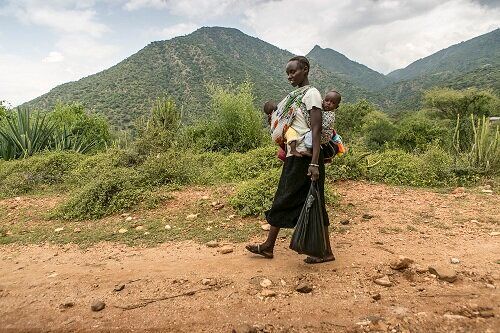Ensuring every malnourished child gets the treatment they need

Nancy's long walk to the centre. Picture copyright ACF Kenya, courtesy of Samuel Hauenstein Swan
The treatment of malnutrition has revolutionised over the last few years, with the development of Ready to-Use Therapeutic Foods meaning more children than ever can receive life-saving treatment at home, in the comfort of their own community.
As such, treatment has been made much more accessible, which has had a huge positive impact on the lives of families affected by malnutrition. Action Against Hunger's latest report Access For All delves deeper into the concept of community based management of malnutrition, exploring just how far we have come over the years.
However, as I recently discovered when I visited West Pokot in Kenya, there are still a high number of malnourished children who are not yet accessing treatment. For Action Against Hunger it is crucial to find out why this is happening and to find solutions that will help more children access the life-saving treatment they need. This can be done through coverage assessments - something which the Coverage Monitoring Network is making much more accessible for humanitarian organisations.
For Nancy, who lives in Kosholio village, the main problem she faces is the distance she needs to walk to get to her nearest distribution centre in Chesta each week. Both her 7 month old twins, Joyline and Belinta are suffering from malnutrition (severe acute malnutrition) and every Thursday she makes her way on a long and bumpy five hour walk to reach the centre, carrying one twin on her front and the other on her back. Once her twins have been weighed and measured and receive their supplies of Ready to-Use Therapeutic Foods to last the week, she then turns back around and faces her five hour return journey home.
And distance is not the only problem that mothers have taking their children for treatment. Some mothers struggle to take a full day away from working in their fields, as a day without work usually means a day without food. Other mother's find it difficult to travel along undeveloped roads, which can often be flooded. And for one mother I spoke to, the reason why she doesn't bring her 2 year old son to the centre is because she cannot afford any clothes for him and is worried about what the other mothers might think of her.
Whilst my time in West Pokot certainly threw up a lot of barriers for families, it also showed me that for every problem, there is almost always a solution that can be found. Whether it's increasing the mobility of programmes, capacity building more health centres to treat malnutrition, investing time in training more Community Health Workers, or even something as simple as making sure there are children's clothes available at centres, it is possible to make accessing treatment easier.
Now that the barriers to accessing treatment have been identified in West Pokot, Action Against Hunger will focus on implementing effective solutions.
Our aim is to ensure that one day in West Pokot, there truly will be access for all.